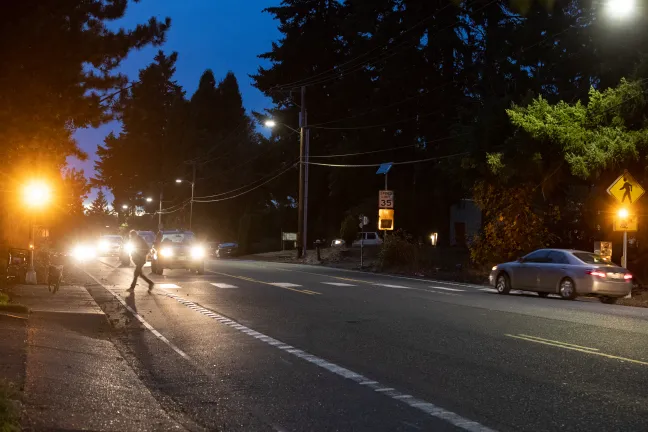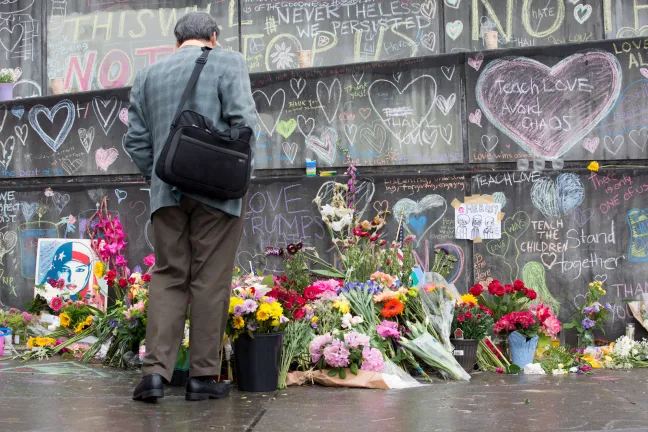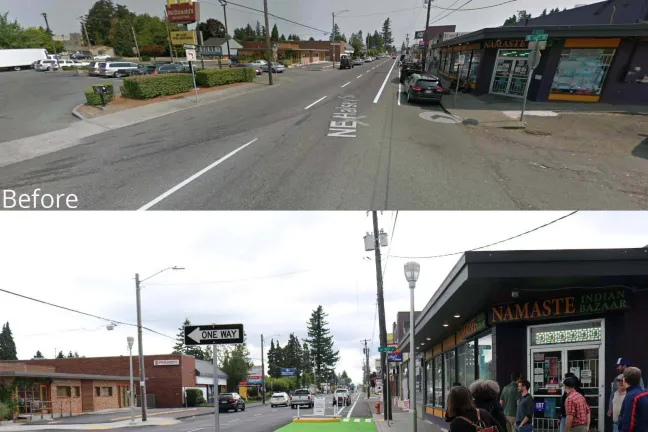Racial and Ethnic Approaches to Community Health, or REACH, a project of Multnomah County’s Public Health Division, released a
According to REACH’s report, African Americans are more likely to die in traffic crashes on Portland streets, more likely to be stopped by police in traffic-related incidents, more likely to avoid outdoor physical activity because of the risk of harassment and bias crimes, and more likely to face long wait times before drivers stop to let them cross the street.
“These are individuals — our sisters, brothers, mothers, fathers and friends,” Prevention and Health Promotion Director Tameka Brazile told the Board on Thursday as Public Health and Environmental Health staff presented the findings of their year-old effort.
Brazile, who is African American, said her daughter and granddaughter were in a serious crash in 2017, requiring multiple operations. Her daughter had to learn how to walk again. And two of Brazile’s colleagues lost loved ones in traffic crashes last year.
Injury is the leading cause of death among people ages 1 to 45 in Multnomah County, and Black residents die at a higher rate than White residents.
Multnomah County has little direct power over the region’s transportation infrastructure, but as the Local Public Health Authority, it is responsible for the wellbeing of all of the County’s residents. And exposure to racism directly harms people’s health and wellbeing.
“There is no system not influenced by race,” Brazile said. “Transportation choices influence health through physical activity, crashes and exposure to pollutants. We know that walkable, bikeable transit-oriented communities are associated with healthier populations. Transportation is a key social determinant of health.”
“Transportation is a public health issue,” she said. “This is our lane.”
The Findings
REACH worked in partnership with the Multnomah County Environmental Health program, which supported the study with data analysis and also helped draft policy goals.
“One purpose is to provide a baseline to measure progress towards a more equitable transportation system,” explained Environmental Health’s Brendon Haggerty. “We expanded the definition of transportation safety beyond fatal or severe injury to encompass the experience people have.”
They focused on fatalities, injuries, bias, harassment, policing and violent crime.
The analysis drew on a diverse set of data sources and methods, including death certificate data from 2013 through 2017, and data on emergency room visits from 2016 through 2018. And research literature and interviews with area committees and community groups, including City of Portland transportation surveys and data from the Local Public Safety Coordinating Council.
Among their findings:
-
Fatal injury: Death rates from crash injuries among Black residents were nearly twice the rate among white residents from 2013 through 2017. And that disparity had grown when compared to the previous five-year period.
-
Nonfatal injury: Data from emergency department and urgent care visits suggests Black residents were overrepresented among those seeking care for injuries sustained during traffic crashes from 2016 to 2018. They represented 17 percent of patients but only about 8 percent of the County’s population. An analysis of roads with the highest numbers of traffic injuries showed 77 percent of the length of those roads passes through or along Census tracts with high concentrations of Black and African American residents.
-
Bias behavior: Drawing on survey responses developed by the City of Portland as it prepared for changes in its pedestrian master plan, Black Portlanders reported, in a paper titled Walking While Black, that Black pedestrians trying to cross a road had to wait longer than white pedestrian, and data from Portland State University showed Black pedestrians had to wait for twice as many cars, and wait 32 percent longer.
-
Harassment: Data from the Portland Police Bureau shows that race was the most common cause listed in reports of bias crimes, comprising 21 percent of total reports. Offenders were mostly white, mostly male and often strangers.
Research for the
But fresh data continues to underscore the disparities laid bare in this report. And the pandemic, health officials say, is also helping to make these disparities even worse.
The City of Portland this week released its Vision Zero Traffic Crash Report 2020, showing that Black people accounted for 10 traffic fatalities in the city last year, out of a total of 54. That’s 18.5 percent of traffic deaths — which is three times higher than Black residents’ share of Portland’s population.
An analysis of national police data by analyst and activist Samuel Sinyangwe also suggests that Portland police officers arrest Black residents at more than four times the rate at which they arrest white Portlanders — the fifth-highest disparity of any large city in the nation.
And violent crime jumped sharply last year. The monthly average number of shootings was 105 from July 2020 through January 2021, three times the average monthly average of the preceding year and a half.
“We’re here to bring a really important report forward that was put on hold, as much of our work in public health was, as we stood up a response to COVID-19,” Public Health Director Jessica Guernsey told the Board on Thursday. “We are excited to be back in front of you to resurrect some of these important data points that unfortunately have been aggravated by COVID-19.”
The Next Step
Traffic safety affects community members’ ability to access healthy food, jobs and education, REACH Program Manager Charlene McGee told the Board. It also affects their choices about how to spend time outside, and may lead to question whether spending that time outside is even safe.
This week marked the anniversary of the murder of Ahmaud Arbery, who was shot by white men on Feb. 23, 2020, as he went for a Sunday afternoon jog in his southern Georgia neighborhood.
“As a mother to a Black son, it’s important to acknowledge what it means when we talk about safety in the right of way,” McGee said. “The fears and anxiety we experience just by being.… The simple act of our children going to ride a bike creates fear and a level of stress that we should not encounter simply by being in a public space.”
McGee laid out REACH’s next steps: engagement with the community to better define what safety means for Black people in Multnomah County, and work to partner with New York-based Regional Planning Association to influence local and regional governments to center racial equity in transportation planning.
“I’m starting to think all policy is health policy,” Commissioner Susheela Jayapal said after the presenters had finished. “The way you connected the dots between transportation and health policy. Perceptions of safety and lack of safety. I hadn’t thought of all the ramifications and how that translates into health outcomes.”
Although the County’s direct control over transportation infrastructure is limited, Jayapal said the County certainly has power to advocate for policy changes with the other governments that do exert direct control. She sits on the Metro Policy Advisory Committee, a body composed of elected local officials who weigh in on regional transportation planning, and she encouraged the presenters to share their findings at an upcoming meeting.
Commissioner Jessica Vega Pederson sits on Metro’s Joint Policy Advisory Committee on Transportation, and also urged the presenters to share the report with that committee as well.
Vega Pederson, who lives in mid-County, said she constantly sees pedestrians waiting to cross the street, only to be ignored by cars, even at formally marked crosswalks. And it seems to happen more often to people of color.
“All of us are responsible for changing our behaviors,” she said. “What struck me was how you defined safety, because it’s comprehensive. Usually we don’t look at harassment, over-policing. Those all go into how safe people feel getting out in their environments.”
“This report is sobering,” said Commissioner Lori Stegmann, noting that most people wouldn’t easily see a correlation between transportation and social problems such as harassment, over-policing and bias.
“Those don’t come to people’s top of mind,” she said. “But this shouldn’t be an afterthought. This should be built into any current or future transportation project.”
Stegmann invited REACH and Environmental Health to present to the East Multnomah County Transportation Committee. She also asked the presenters to confirm her understanding that drivers are always supposed to stop for pedestrians at an intersection.
“Yes,” Haggerty confirmed, whether the intersection has a crosswalk or not. It’s the law.
REACH and Environmental Health laid out three recommendations for the Board of Commissioners to consider.
“We recommend using this report as a baseline to set targets for improvement and measure progress,” Haggerty said. “This is an issue of what gets counted, counts.”
The team urged policymakers to join them as they engage with community organizations to talk through data analysis and discuss transportation proposals and recommendations — compensating groups for their expertise and time.
Finally the presenters recommended that government bodies make infrastructure changes that include speed control and mode separation on urban streets, as well as set speed limits of no more than 30 miles per hour.
“I’m impressed you have had time to work on anything other than COVID-19, but these are interrelated and important issues,” said Chair Deborah Kafoury. “I know there will be more conversations about how to put these policy ideas into practice.”



